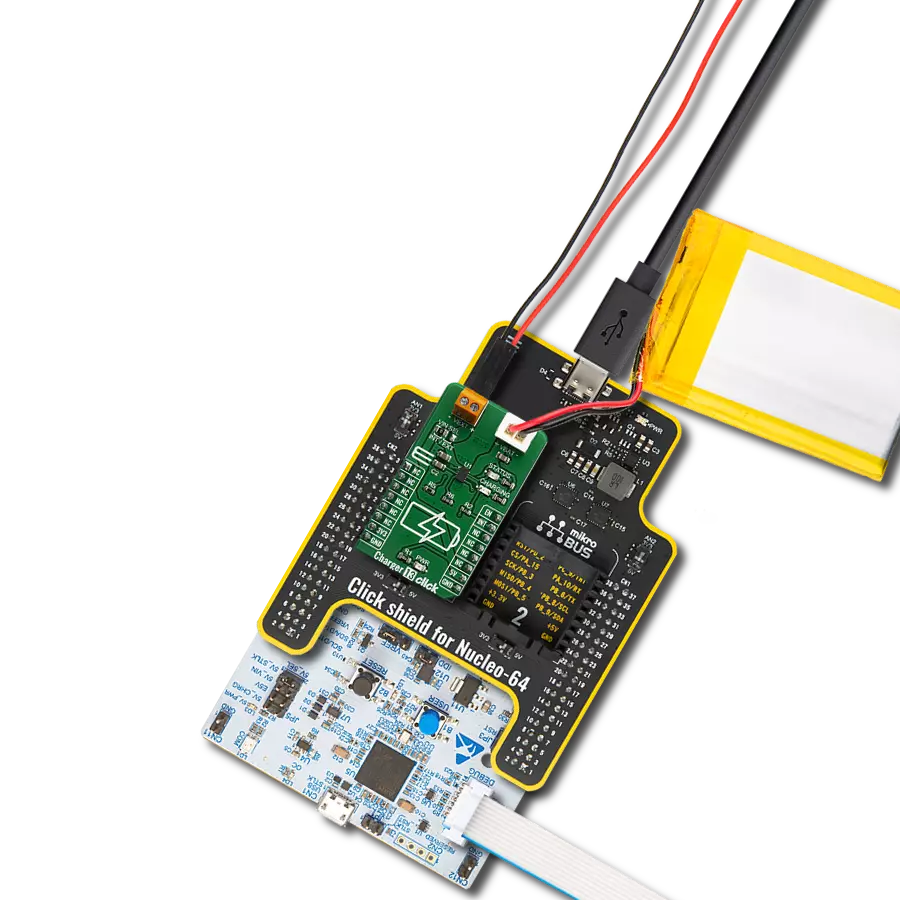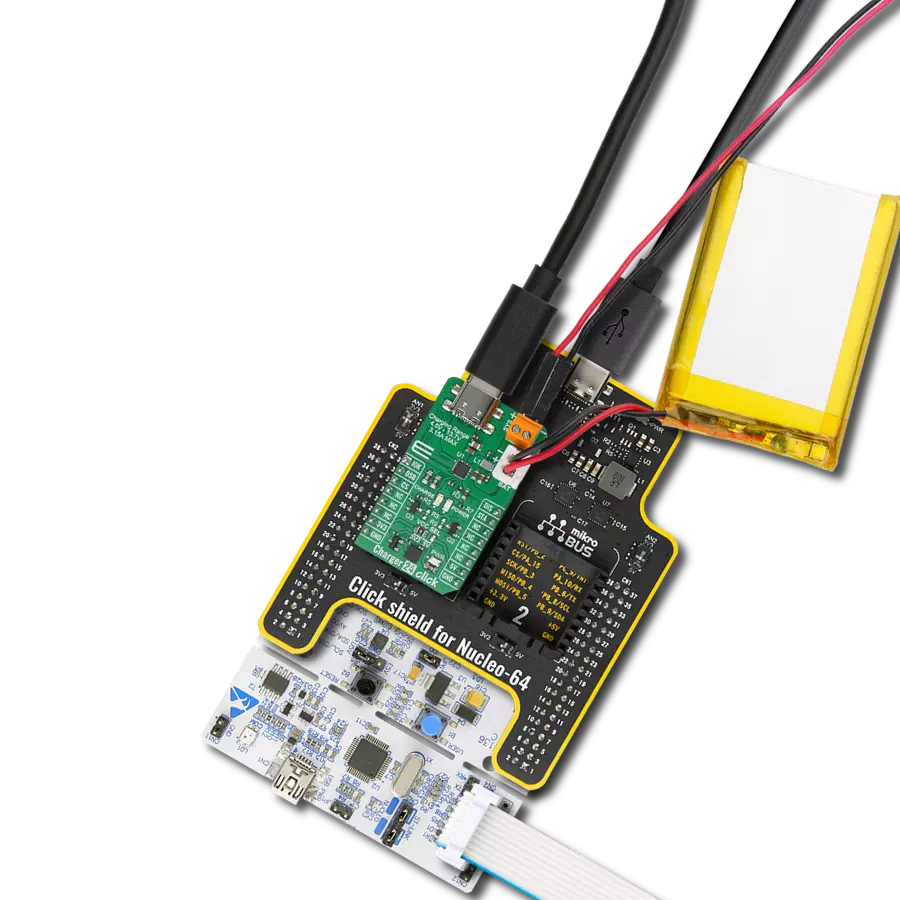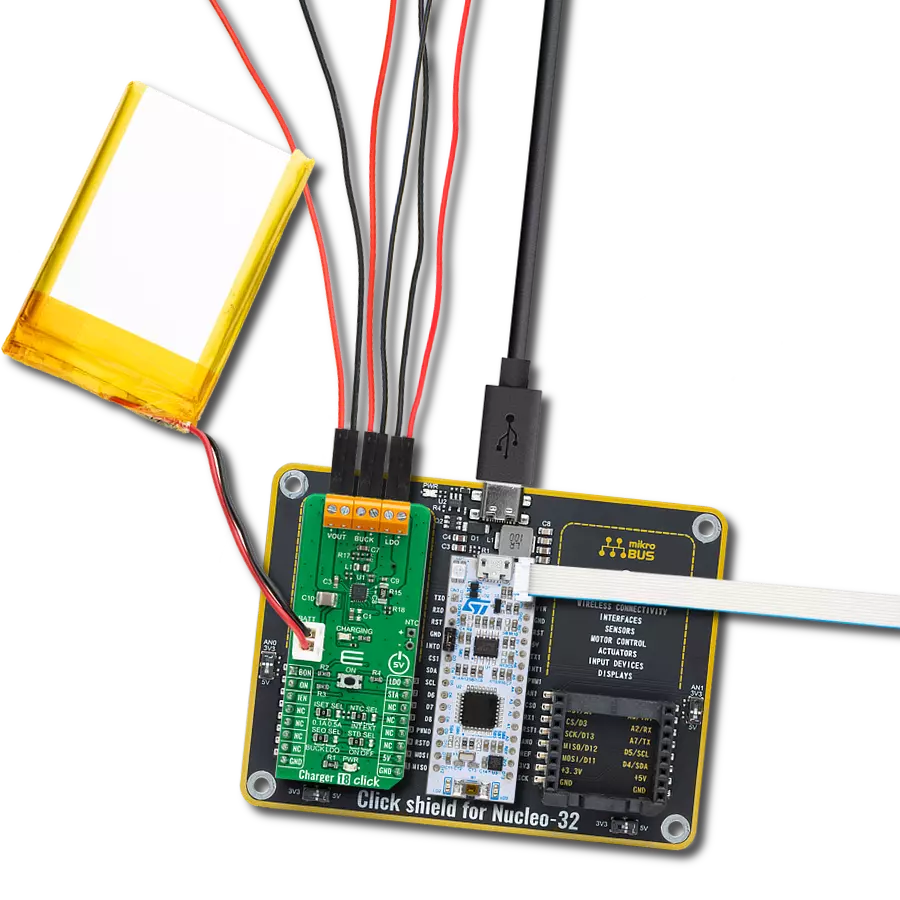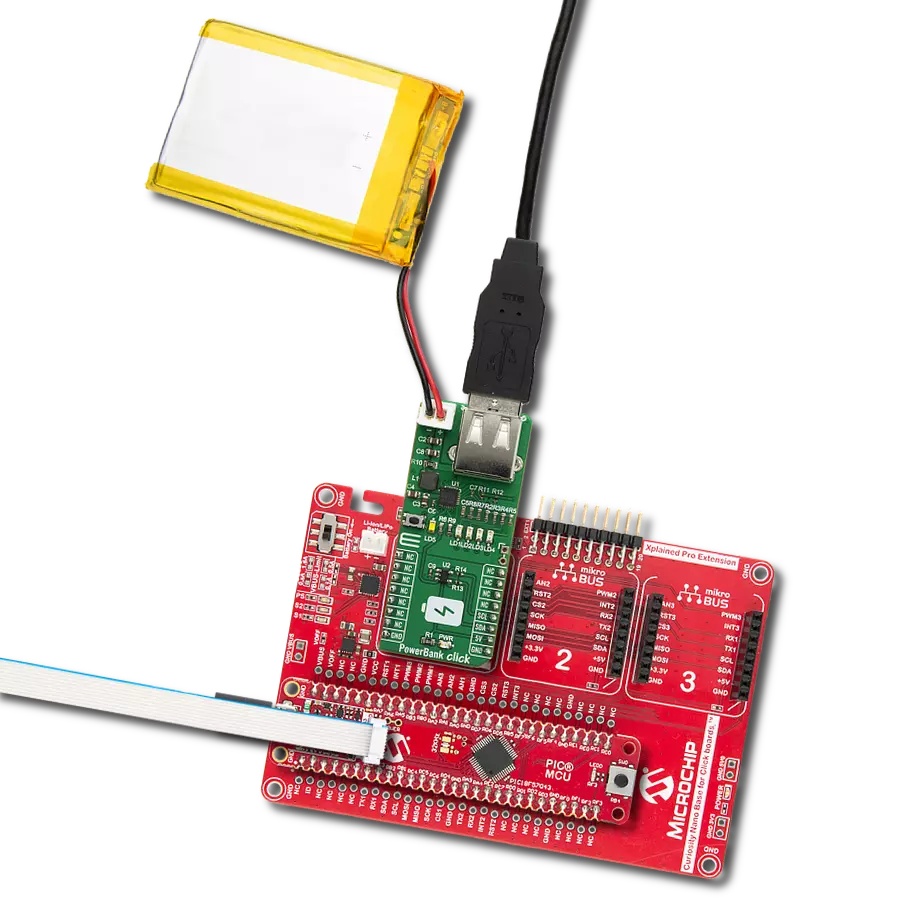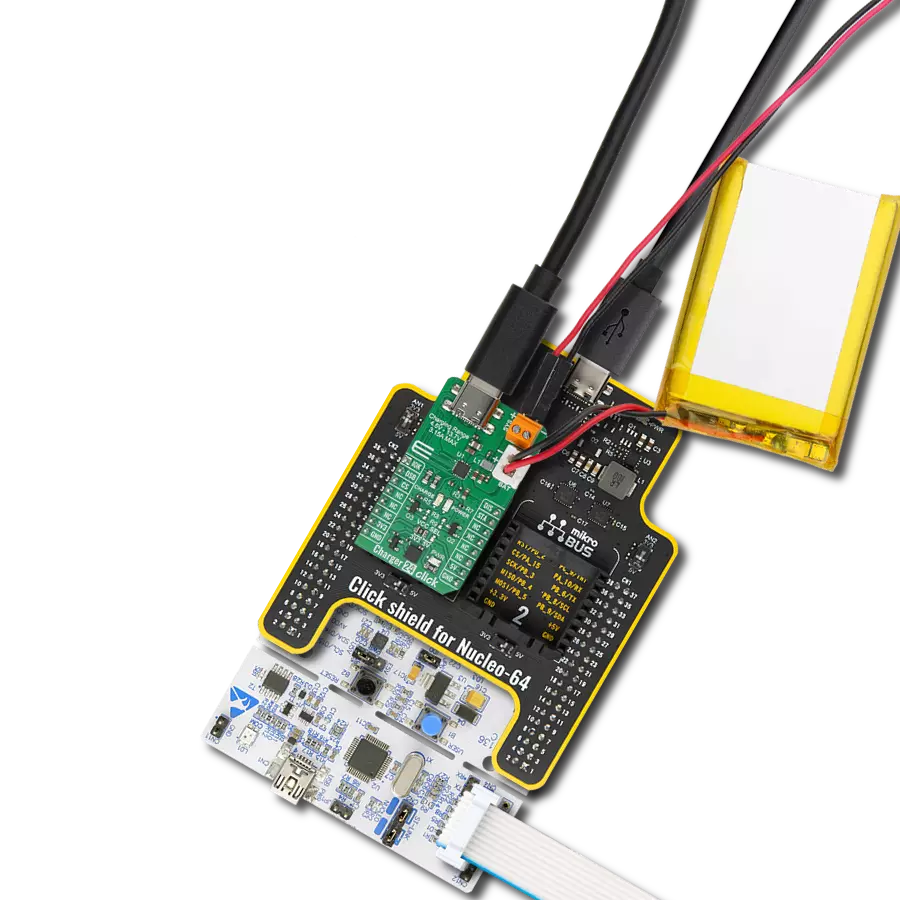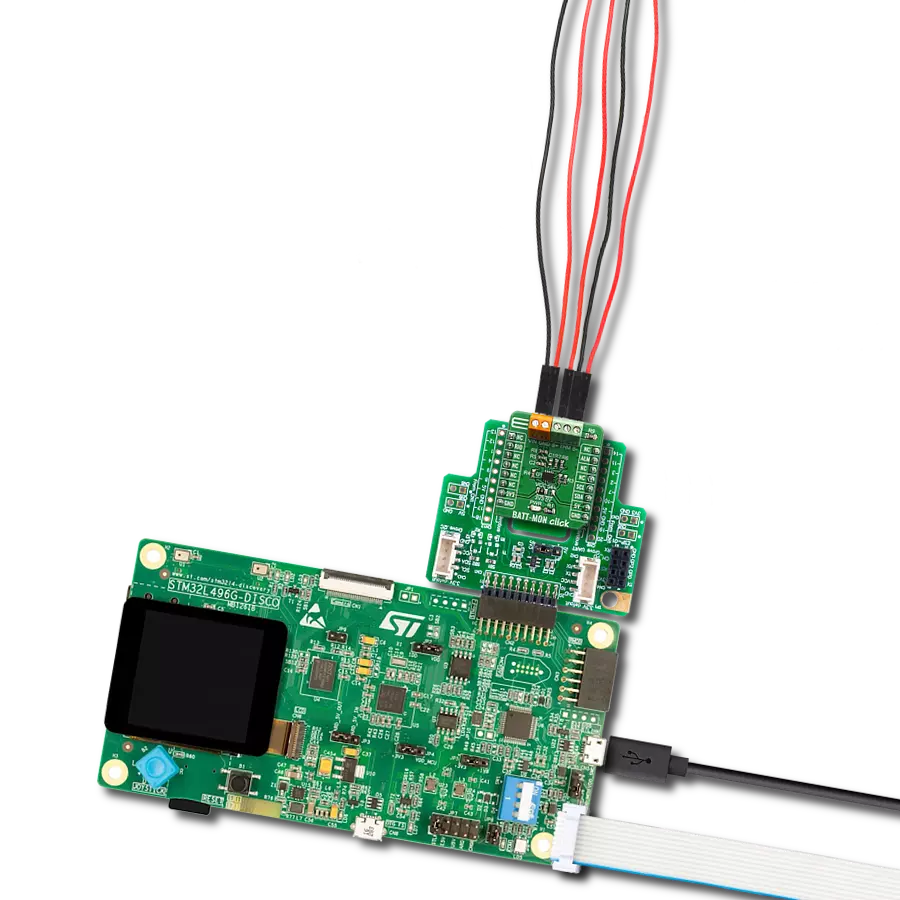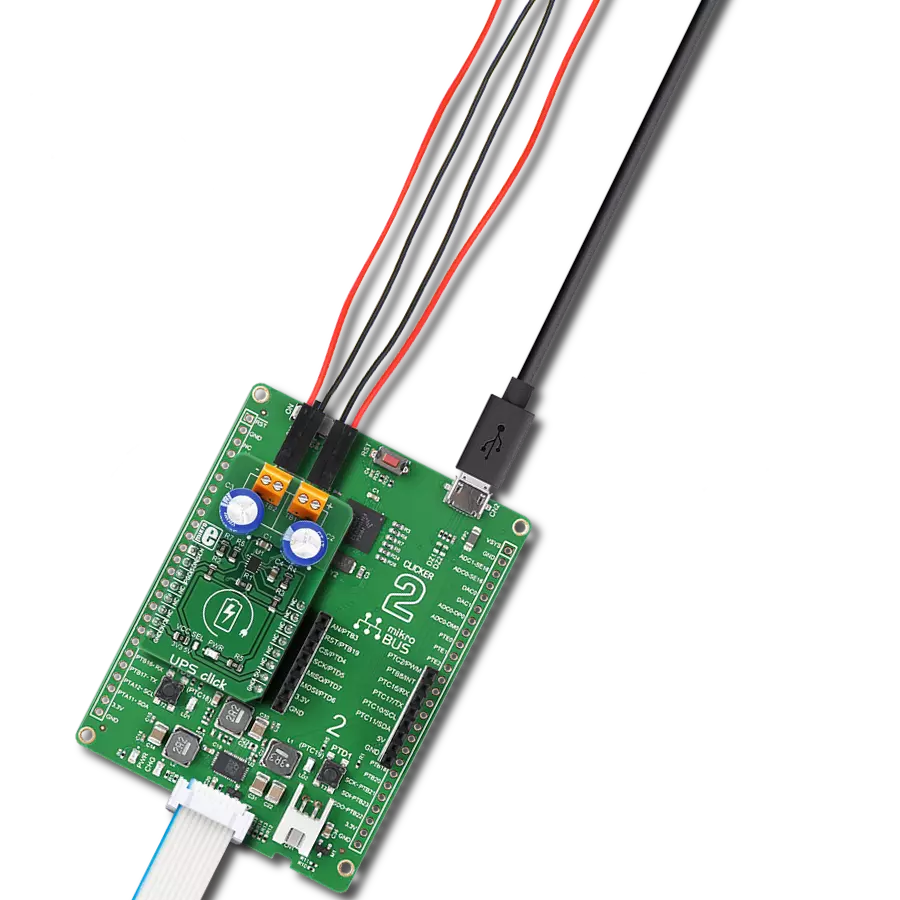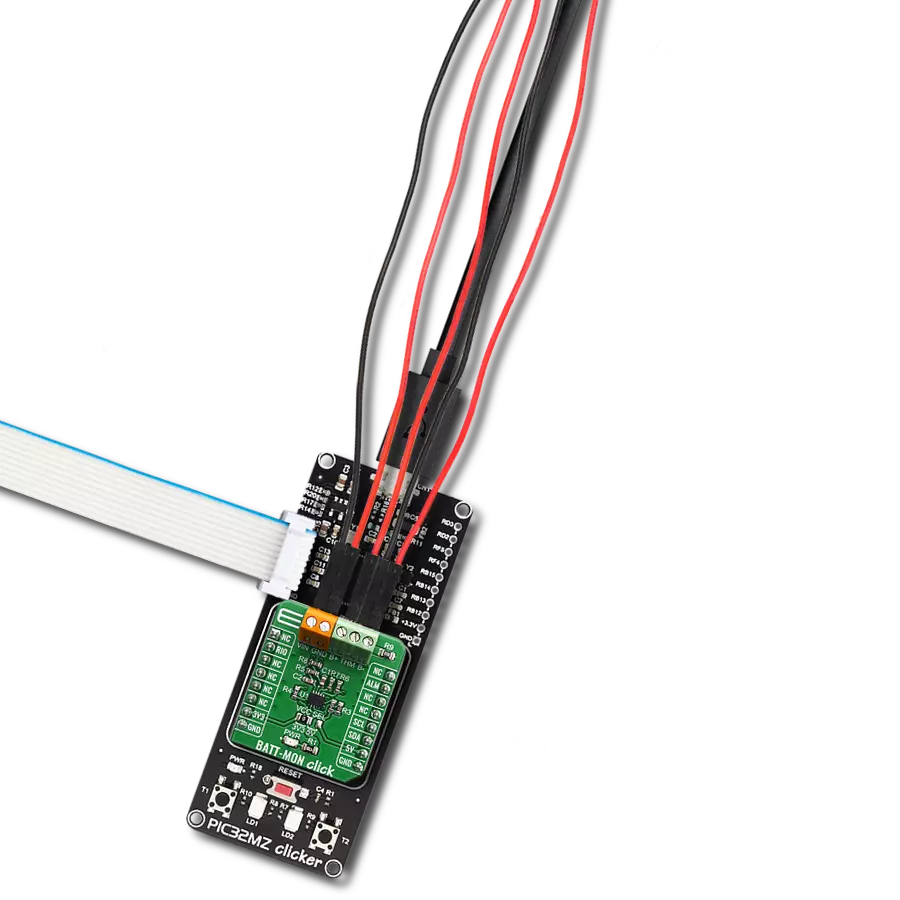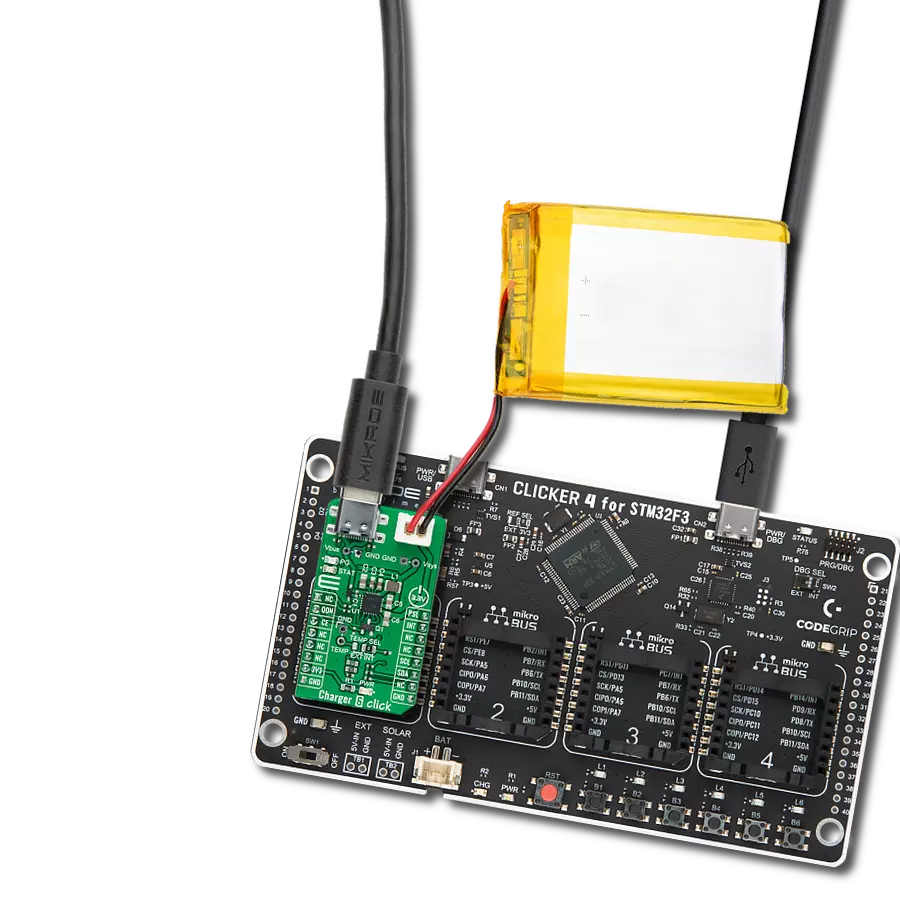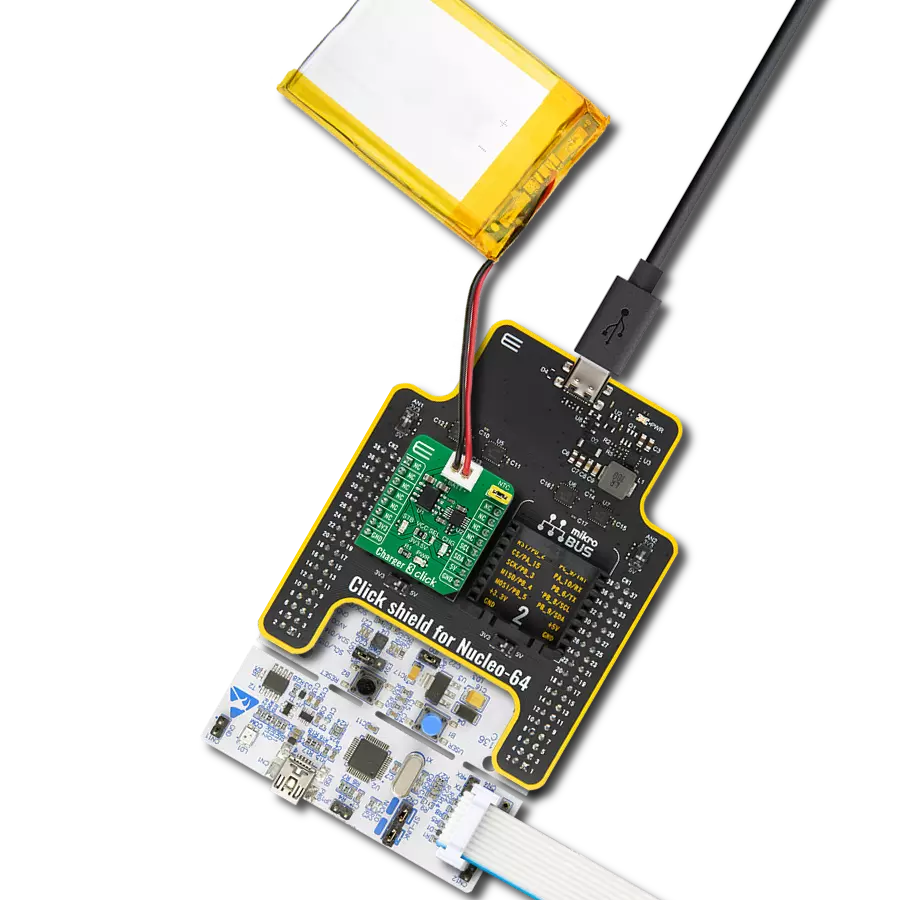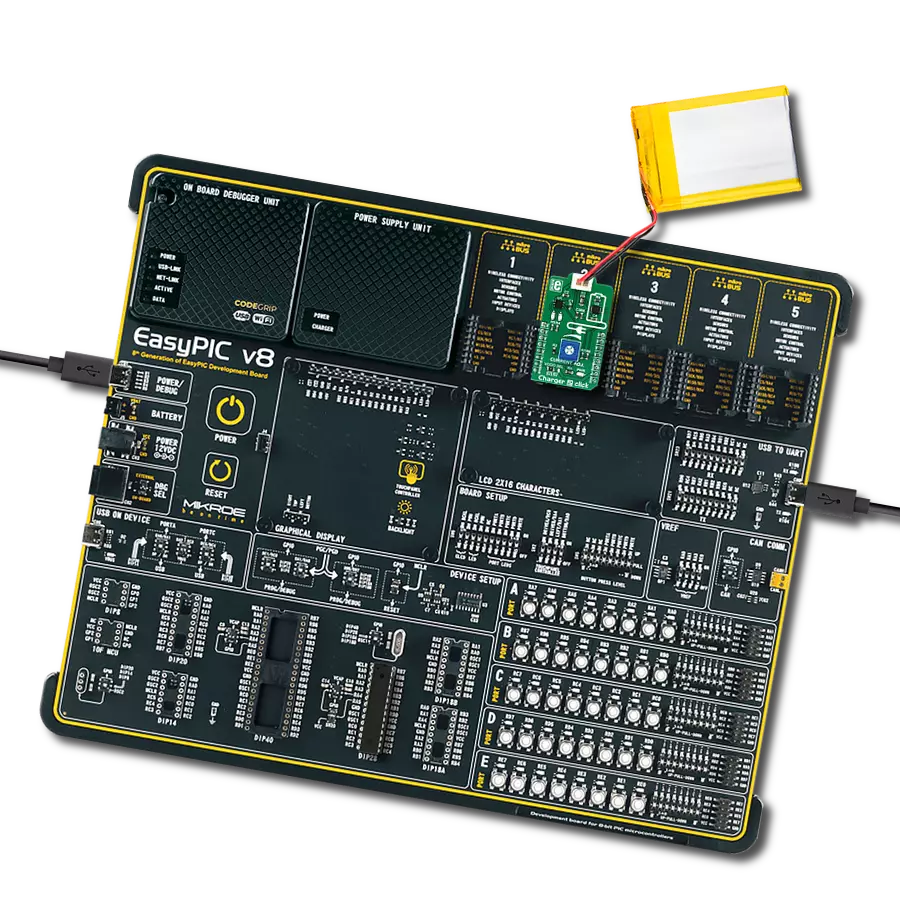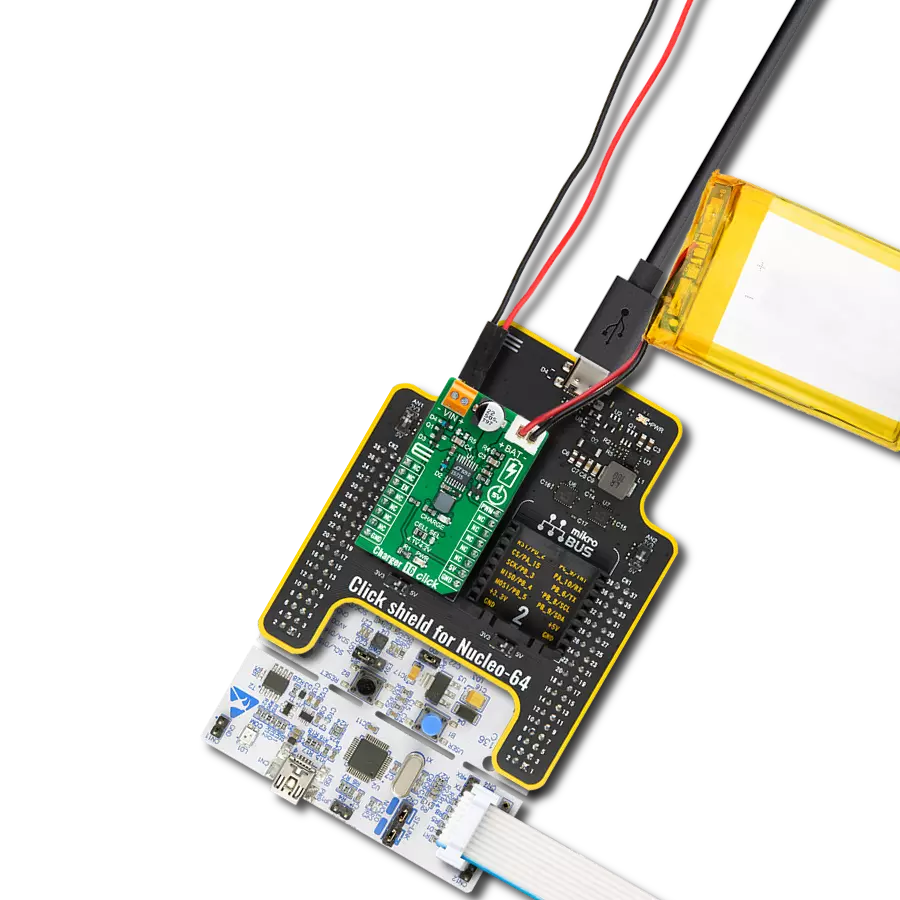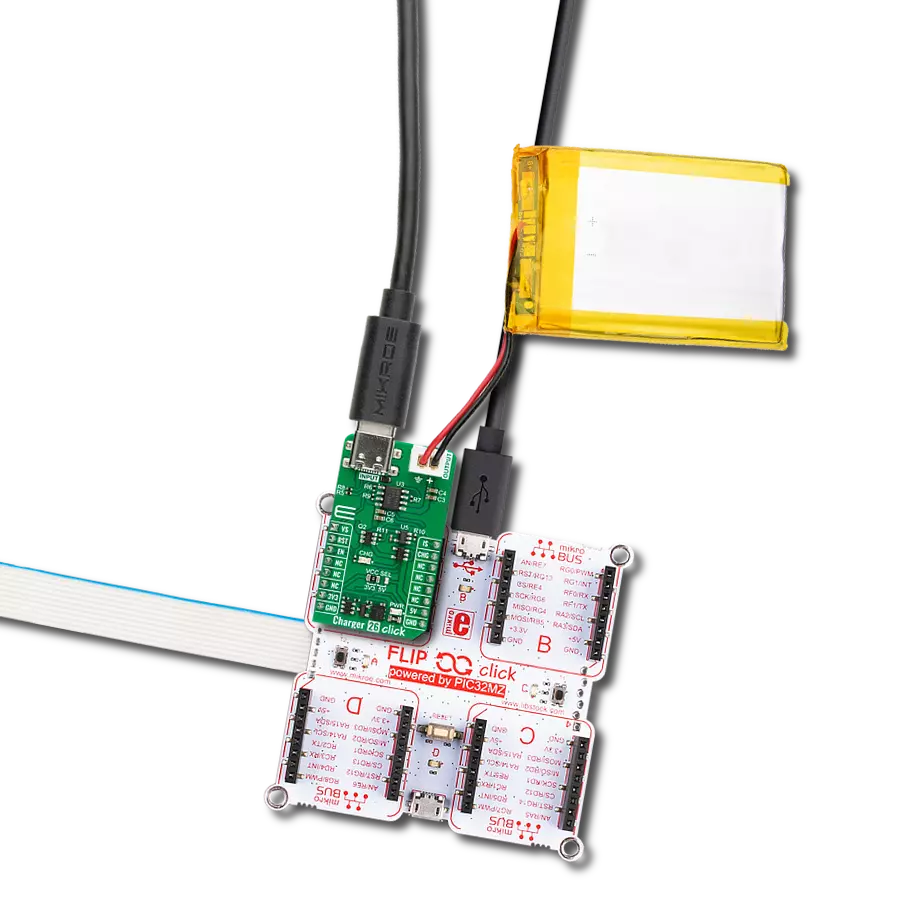A battery monitoring solution that provides valuable insights into your battery's performance, helping you identify issues and optimize its usage
A
A
Hardware Overview
How does it work?
BATT-MON Click is based on the STC3115, a high-precision battery gas gauge IC with alarm output for handheld applications, from STMicroelectronics. It includes all necessary components for the STC3115 to ensure the proper functionality of the Click board™ and maintain the monitoring precision. The monitoring functions include the measurement of battery voltage, current, and temperature. A Coulomb counter is available to track the SOC when the battery is charging or discharging at a high rate. A sigma-delta A/D converter measures the voltage, current, and temperature. The STC3115 can operate in two different modes with different power consumption. Mode selection is made by the VMODE bit in register 0. For more information about registers and operating
modes, refer to the modes STC3115 datasheet. Battery voltage is measured by using one conversion cycle of the A/D converter every 4 s. The conversion cycle takes 8192 clock cycles, which means that when the internal 32768Hz clock is used, the conversion cycle time is 250ms. The voltage range is 0 to 4.5V, and the resolution is 2.20mV. The accuracy of the voltage measurement is ±0.5% over the temperature range. This allows accurate SOC information from the battery open-circuit voltage. The voltage drop across the sense resistor (R9) for current sensing is measured with the internal 14-bit sigma-delta A/D converter. Using the 32768Hz internal clock, the conversion cycle time is 500 ms for a 14-bit resolution. The LSB value is 5.88μV. The A/D converter output is in two’s complement format.
When a conversion cycle is completed, the result is added to the Coulomb counter accumulator, and the number of conversions is incremented in a 16-bit counter. The current register is updated only after the conversion closest to the voltage conversion (once per 4s measurement cycle). The result is stored in the REG_CURRENT register. This Click board™ can operate with either 3.3V or 5V logic voltage levels selected via the VCC SEL jumper. This way, both 3.3V and 5V capable MCUs can use the communication lines properly. However, the Click board™ comes equipped with a library containing easy-to-use functions and an example code that can be used, as a reference, for further development.
Features overview
Development board
Clicker 2 for Kinetis is a compact starter development board that brings the flexibility of add-on Click boards™ to your favorite microcontroller, making it a perfect starter kit for implementing your ideas. It comes with an onboard 32-bit ARM Cortex-M4F microcontroller, the MK64FN1M0VDC12 from NXP Semiconductors, two mikroBUS™ sockets for Click board™ connectivity, a USB connector, LED indicators, buttons, a JTAG programmer connector, and two 26-pin headers for interfacing with external electronics. Its compact design with clear and easily recognizable silkscreen markings allows you to build gadgets with unique functionalities and
features quickly. Each part of the Clicker 2 for Kinetis development kit contains the components necessary for the most efficient operation of the same board. In addition to the possibility of choosing the Clicker 2 for Kinetis programming method, using a USB HID mikroBootloader or an external mikroProg connector for Kinetis programmer, the Clicker 2 board also includes a clean and regulated power supply module for the development kit. It provides two ways of board-powering; through the USB Micro-B cable, where onboard voltage regulators provide the appropriate voltage levels to each component on the board, or
using a Li-Polymer battery via an onboard battery connector. All communication methods that mikroBUS™ itself supports are on this board, including the well-established mikroBUS™ socket, reset button, and several user-configurable buttons and LED indicators. Clicker 2 for Kinetis is an integral part of the Mikroe ecosystem, allowing you to create a new application in minutes. Natively supported by Mikroe software tools, it covers many aspects of prototyping thanks to a considerable number of different Click boards™ (over a thousand boards), the number of which is growing every day.
Microcontroller Overview
MCU Card / MCU
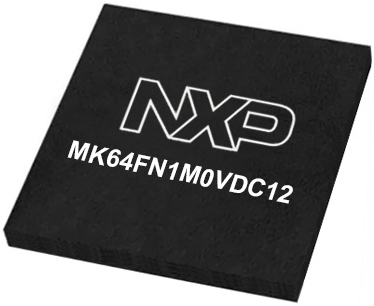
Architecture
ARM Cortex-M4
MCU Memory (KB)
1024
Silicon Vendor
NXP
Pin count
121
RAM (Bytes)
262144
Used MCU Pins
mikroBUS™ mapper
Take a closer look
Click board™ Schematic

Step by step
Project assembly
Software Support
Library Description
This library contains API for BATT-MON Click driver.
Key functions:
battmon_get_data- Data Get functionbattmon_get_alm_pin- ALM Pin Get functionbattmon_reset_conv_cnt- Conversion Counter Reset function
Open Source
Code example
The complete application code and a ready-to-use project are available through the NECTO Studio Package Manager for direct installation in the NECTO Studio. The application code can also be found on the MIKROE GitHub account.
/*!
* \file
* \brief BattMon Click example
*
* # Description
* This application is battery charger.
*
* The demo application is composed of two sections :
*
* ## Application Init
* Initializes I2C serial interface, reads the part ID and
* performs a device configuration and alarm setting.
*
* ## Application Task
* Checks the conversion counter value and when conversion was done
* reads data calculated to the properly unit and checks the alarm status.
* All results will be sent to the uart terminal.
*
* *note:*
* Voltage and current conversion will be done after 4 seconds.
* Temperature conversion will be done after 16 seconds.
* After temperature reading the conversion counter will be cleared.
* Clearing the alarm while the corresponding low-voltage or low-SOC condition is still in progress
* does not generate another interrupt. This condition must disappear first and must be detected again
* before another interrupt (ALM pin driven low or alarm interrupt bits are set high) is generated for this alarm.
* Another alarm condition, if not yet triggered, can still generate an interrupt.
* Input voltage must be in the range from 2.7V to 4.5V.
* Maximal battery current is 5A.
*
* \author MikroE Team
*
*/
// ------------------------------------------------------------------- INCLUDES
#include "board.h"
#include "log.h"
#include "battmon.h"
// ------------------------------------------------------------------ VARIABLES
static battmon_t battmon;
static log_t logger;
static uint8_t reg_read;
// ------------------------------------------------------ APPLICATION FUNCTIONS
void application_init ( void )
{
log_cfg_t log_cfg;
battmon_cfg_t cfg;
/**
* Logger initialization.
* Default baud rate: 115200
* Default log level: LOG_LEVEL_DEBUG
* @note If USB_UART_RX and USB_UART_TX
* are defined as HAL_PIN_NC, you will
* need to define them manually for log to work.
* See @b LOG_MAP_USB_UART macro definition for detailed explanation.
*/
LOG_MAP_USB_UART( log_cfg );
log_init( &logger, &log_cfg );
log_info( &logger, "---- Application Init ----" );
// Click initialization.
battmon_cfg_setup( &cfg );
BATTMON_MAP_MIKROBUS( cfg, MIKROBUS_1 );
battmon_init( &battmon, &cfg );
Delay_ms ( 500 );
battmon_read_bytes( &battmon, BATTMON_REG_ID, ®_read, 1 );
log_printf( &logger, " ** Part ID: 0x%d \r\n", (uint16_t) reg_read );
battmon_default_cfg( &battmon );
log_printf( &logger, "** BattMon initialization done ** \r\n" );
log_printf( &logger, "********************************* \r\n" );
}
void application_task ( void )
{
char cels_symbol[ 3 ] = { 176, 'C', 0 };
float data_read;
uint16_t conv_cnt;
conv_cnt = battmon_get_data( &battmon, BATTMON_REG_COUNTER );
if ( ( ( conv_cnt % 4 ) == 0 ) && ( conv_cnt > 0 ) )
{
data_read = battmon_get_data( &battmon, BATTMON_REG_SOC );
log_printf( &logger, "** Gas Gauge Relative SOC : %.2f %% \r\n ", data_read );
data_read = battmon_get_data( &battmon, BATTMON_REG_CURRENT );
log_printf( &logger, "** Battery Current : %.2f mA \r\n", data_read );
data_read = battmon_get_data( &battmon, BATTMON_REG_VOLTAGE );
log_printf( &logger, "** Battery Voltage : %.2f mV \r\n", data_read );
if ( ( conv_cnt % 16 ) == 0 )
{
data_read = battmon_get_data( &battmon, BATTMON_REG_TEMPERATURE );
battmon_reset_conv_cnt( &battmon );
log_printf( &logger, "** Temperature : %.2f %s\r\n", data_read, cels_symbol );
}
reg_read = battmon_check_clear_alarm( &battmon );
if ( ( reg_read & BATTMON_ALM_SOC_DET_MASK ) != BATTMON_LOG_LOW )
{
log_printf( &logger, "** Low-SOC Condition! \r\n" );
}
if ( ( reg_read & BATTMON_ALM_VOLT_DET_MASK ) != BATTMON_LOG_LOW )
{
log_printf( &logger, "** Low-Voltage Condition! \r\n" );
}
log_printf( &logger, "********************************* \r\n" );
Delay_ms ( 1000 );
}
else
{
Delay_ms ( 200 );
}
}
int main ( void )
{
/* Do not remove this line or clock might not be set correctly. */
#ifdef PREINIT_SUPPORTED
preinit();
#endif
application_init( );
for ( ; ; )
{
application_task( );
}
return 0;
}
// ------------------------------------------------------------------------ END
Additional Support
Resources
Category:Battery charger


















